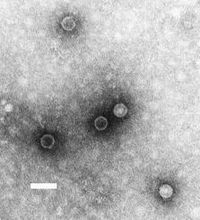
Photo from wikipedia
ABSTRACT Introduction: Ending all cases of poliomyelitis requires successful cessation of all oral poliovirus vaccine (OPV), but the Global Polio Eradication Initiative (GPEI) partners should consider the possibility of an… Click to show full abstract
ABSTRACT Introduction: Ending all cases of poliomyelitis requires successful cessation of all oral poliovirus vaccine (OPV), but the Global Polio Eradication Initiative (GPEI) partners should consider the possibility of an OPV restart. Areas covered: We review the risks of continued live poliovirus transmission after OPV cessation and characterize events that led to OPV restart in a global model that focused on identifying optimal strategies for OPV cessation and the polio endgame. Numerous different types of events that occurred since the globally coordinated cessation of serotype 2-containing OPV in 2016 highlight the possibility of continued outbreaks after homotypic OPV cessation. Modeling suggests a high risk of uncontrolled outbreaks once more than around 5,000 homotypic polio cases occur after cessation of an OPV serotype, at which point restarting OPV would become necessary to protect most populations. Current efforts to sunset the GPEI and transition its responsibilities to national governments poses risks that may limit the ability to implement management strategies needed to minimize the probability of an OPV restart. Expert commentary: OPV restart remains a real possibility, but risk management choices made by the GPEI partners and national governments can reduce the risks of this low-probability but high-consequence event.
Journal Title: Expert Review of Vaccines
Year Published: 2018
Link to full text (if available)
Share on Social Media: Sign Up to like & get
recommendations!